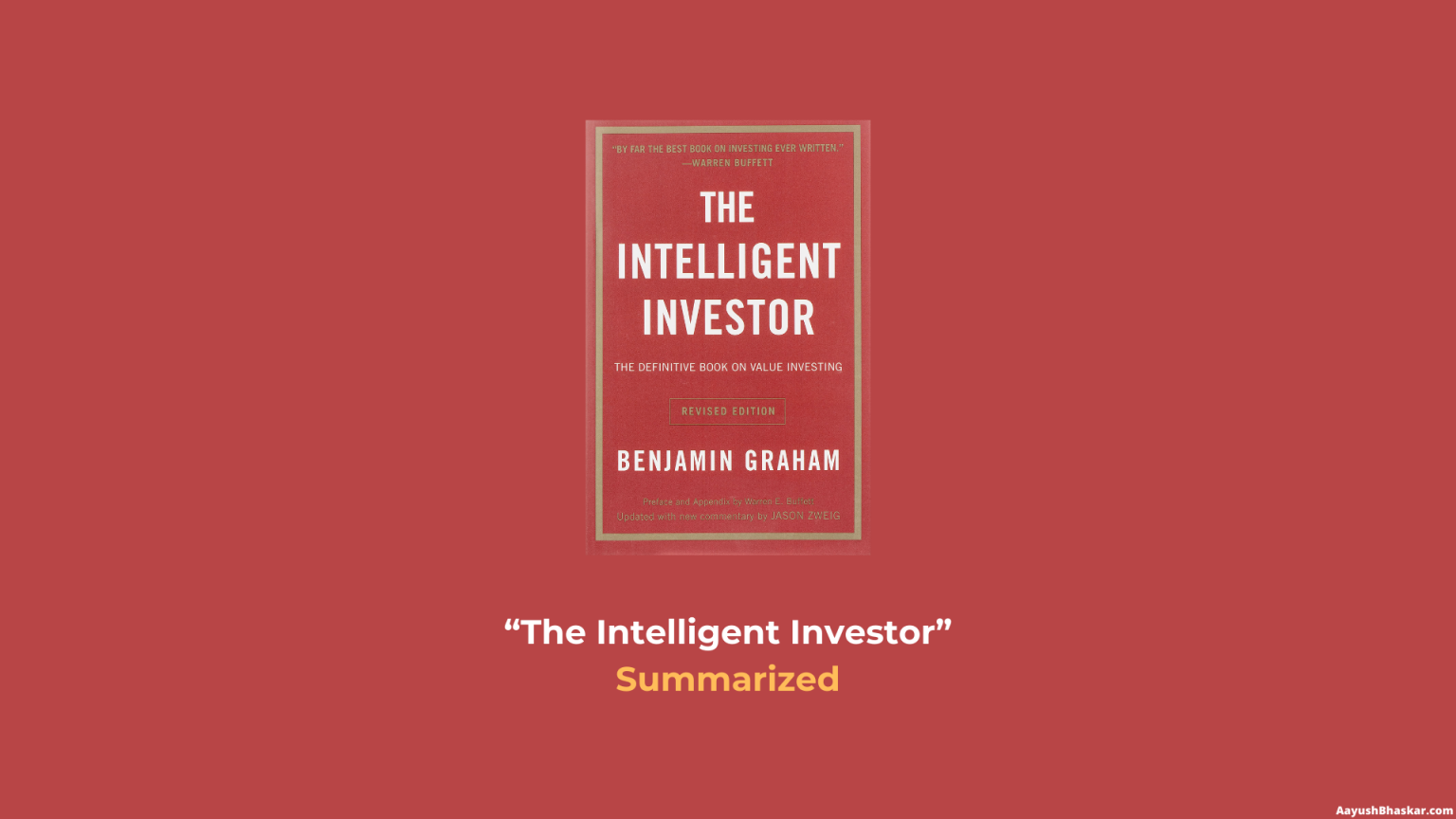“I want to read finance and investment books, but my day job takes too much of my brainpower.”
“Man, I wish I could read that Peter Lynch book, but the Dan Brown on my table looks much more appealing.”
Do you find yourself saying these sentences often?
Do you want to read finance books, but they are too bulky or time-consuming for you?
Don’t worry; we have you covered.
We understand that finance books seem like a drag, no matter how rewarding they might be.
So, we’ve curated a series to help you save time and effort –
Finance Vedas are summarized in 5 minutes or less.
…………………………………………………………………………………………………………..
I am currently reading ‘The Intelligent investor” for the second time, and I must say, what a goldmine this book is!
Popularized as the “Bible of Investing,” this book provides a sound intellectual framework. It guides the investors in keeping their emotions in check on the roller coaster ride that investing can be.
The book was originally published in 1949 by Benjamin Graham, known as the father of value investing, and has been widely accepted by practitioners like Warren Buffett over the decades. In fact, if it weren’t for Graham and his teachings, Warren Buffett probably wouldn’t be one of the greatest investors the world has seen.
So, here is “The Intelligent Investor” summarized for people in a rush….

If you think Graham refers to someone with a fancy finance degree or a high IQ as an intelligent investor, then here’s the good news for you. He is not.
All one needs to become a successful investor is a basic understanding of the financial statements of a company, presence of mind, and a solid mindset of trusting your own assessment rather than the noise of the market.
Now, while Graham advocates that every investor knows what is best for them, he does provide a framework or a thought process, if you must say, to investors, to help them on their journey.
Here are some of my favorite takeaways from the book:
1. Are you investing or speculating?
Let’s get the basics out of the way first.
If you are looking for a “get rich quick” scheme, or if timing the market and trading give you the adrenaline, maybe you should skip this book.
An intelligent investor is not about getting crazy profits; it is about developing a sound mental framework that equips you with the decision-making ability to make the right investments at the right price.
The first step to becoming an intelligent investor is understanding what an investor is. According to Graham, you’re an investor when:
- You do a thorough and detailed analysis of the company and have a long-term orientation.
- Your safety of principle is not compromised
- there’s a potential to earn average returns
- You understand diversification
- you don’t chase quick profits and expect safe & steady returns from your portfolio.
Whatever activities do not fulfill the above criteria are speculative in nature. And this book enlists numerous examples which show that you’ll be better off without engaging in speculation.

2. Stick to basics
An intelligent investor is not someone who can predict the next multi-bagger.
Rather, intelligent investing is a well-thought process that involves careful study of a business, its evolution, and its management. An intelligent investor should be able to:
- Separate stock price from its intrinsic value: Investors should never pay a price higher than what the stock is worth. Value investing involves spotting undervalued stocks by analyzing a company’s earnings, assets, dividends, and management. “Buying at discount and selling at par or premium” is the mantra.
- Diversify in a way to reduce risks: Diversification might be boring, but trust Graham on this and be a boring investor. It provides you with a good margin of safety (read: room for error) in the volatile market. Basically, you can’t possibly go wrong with every stock in your portfolio. You might get some winners and some losers, but in the end, you’ll be in green.
- Detach themselves from Mr. Market’s ever-changing views: Graham describes the market as a person who is unpredictable and has mood swings every other second. Investing is less of an intellectual exercise and more of an emotional exercise. Graham advises investors to develop self-awareness, keep realistic expectations, and separate their research-based analysis from changing market sentiments.
3. Define your style of investing before jumping into it
If your heartbeat works in sync with how the market reacts, you’ll be better suited to having an autopilot portfolio that doesn’t require much time and effort.
This requires an almost “ascetic detachment” from the craziness of the markets.
For defensive investors, he suggests the following:
- A defensive portfolio should have an appropriate proportion of stocks and bonds.
- An adequately diversified portfolio with 10-30 stocks without overexposing to a particular sector.
- Large, prominent, and conservatively financed companies are a safe bet for defensive investors.
- A long record of continuous dividends reaching back to at least 20 years.
- No earnings deficit in the last 10 years
- Earnings growth should be greater than 33% in the last 10 years.
- Overpaying for assets and earnings is not recommended. Stick to companies whose market prices are less than 1.5 times the net asset value (assets – liabilities) and companies that have a PE of not more than 20.
Investing in an index fund is an alternative solution to save all the time and effort required to follow the above-mentioned approach. Index funds consist of those companies which more or less fulfill these criteria.
On the other hand, if you’re someone who’d continually research, select and monitor a dynamic portfolio of stocks, bonds, and mutual funds, you’re an enterprising investor. This is physically and mentally demanding.
For enterprising investors, Graham recommends an aggressive portfolio. This requires a lot of work, patience, and the ability to stay unaffected by D-street opinions. The basic principles still apply in this case.
However, an aggressive investor has the flexibility to tweak the requirements depending on the company and its valuation of the company.
For e.g., an investor may be willing to overpay for assets if she values the company at a higher value and thinks highly of the company.
4. Financial Discipline 101
Consistency is king.
You can’t put all your money in your portfolio at once and expect the value to never go down. It is bound to happen.
Why?
Remember, Mr. Market is not always rational and is almost always confused.
Calling it formula investing, Graham recommends adopting a system called dollar-cost averaging. Set aside x% of your income every month/quarter and invest it in your portfolio stock.
This allows you to adapt to the changing moods of the market. This reduces your risk by bringing down your cost of investment and thus increasing the potential return to the process. This is perfect for a defensive investor.
An aggressive investor would take this approach a bit further by researching the macro environment and investing more and more when the market crashes and everybody yells, “SELL!” thereby bringing his cost down.
The Intelligent Investor is definitely worth reading if you’re thinking about it. But until you get the time, hope this article does the trick for you!
More from Benjamin Graham: Ben Graham on Investing, Speculating, and Thinking in Probabilities







Leave a Reply